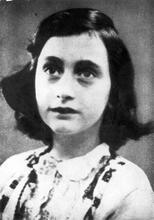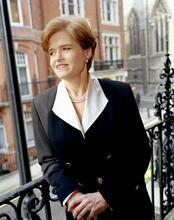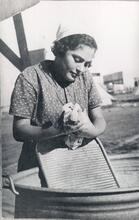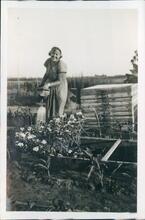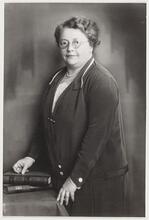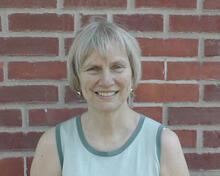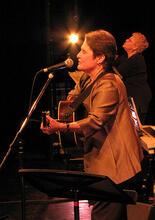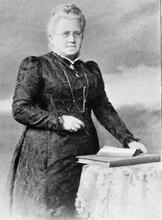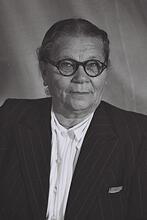Poland: Interwar
Jewish women’s various roles in the interwar period varied among the different communities of Poland. The absorption of middle-class values by Jews resulted in a more circumscribed role for women centered on the home rather than the marketplace, while more traditional Jewish communities maintained a place for women to sell goods in the marketplace. Compulsory education for children of the Polish Republic dubbed the interwar period a time of “victory of schooling,” including for girls. Women also became more politically active during the interwar period, with the growing popularity of Zionist groups like the Women’s International Zionist Organization (WIZO). This period of women’s growing involvement in the public sector was of course interrupted by the tragedy of the Holocaust.
Introduction
According to the Polish census of 1931, women comprised some fifty-two percent of the Polish Jewish community, which means that about 1.6 million of the 3.1 million Jews of Poland were females. This female majority of Polish Jewry, however, finds little echo or attention in the historical literature on the period. To take but the most blatant example of this phenomenon, Raphael Mahler’s classic statistically based socio-economic survey, The Jews of Poland between the Two World Wars, makes not a single reference to women. The most important narrative surveys of Jewish political and economic life in newly independent Poland, such as that of Ezra Mendelsohn, also devote little or no space to the topic of women in Polish Jewish society. The one exception to this rule is the generally weak study by Celia Heller, On the Edge of Destruction; informed by Heller’s own sociological and feminist agenda, it at least makes a first effort to ponder the effect of sexual differences and roles on the Jews’ processes of adjustment to Polish society. Beyond the existing surveys, the monographic literature on Polish Jewry, which has expanded considerably in the past two to three decades, has done little to correct this imbalance. Basic spadework on women’s lives and activities has for the most part never been done. Shaul Stampfer’s study on marriage age, as well as a small number of studies of individuals and movements by Paula Hyman, Daniel Blatman, and a few others, stand out as pathbreaking essays in the field.
Why have topics related to Polish Jewish women attracted so little scholarly interest? Is this but another example, in the words of Barbara Alpern Engel, of historians’ “persistent tendency to assume that the male experience is the universal one”? While this may provide part of the answer, other factors may account for the lack of work on Jewish women. To cite one major factor, we should remember the scholarly literature on Polish Jewry up until now and the operative categories of thought that inform that literature. Until very recent years, the study of Polish Jewry was never far removed from the political agendas of internal Jewish politics and of Polish-Jewish relations. For historians living in interwar Poland or raised in interwar Poland (almost all male, it should be noted), the crucial categories that determined the direction of Polish-Jewish history were nationality (Jews vs. non-Jews), class (working class vs. middle class) or generation (youth vs. parents); issues of gender did not figure into the historical equation. While Raphael Mahler (1899–1977) did not break down his demographic and economic data by gender, Szya Bronsztejn does at least provide basic demographic dta about sex ratios, but little else. His main concerns, like Mahler’s, are ethnic differences, economic structures, and social class, as might be expected from a book published in Communist Poland.
Not that women’s issues are the only neglected topics on the scholarly agenda regarding interwar Polish Jewry. At a time of intense struggle for national rights for the Polish Jewish minority, it is not surprising that the arena which attracted the most attention, both at the time and in retrospective historical accounts, was that of national parliamentary politics. Other fields, such as municipal politics, kehillah politics, or labor union activities, have been generally ignored. Only those “players” in the “major league” of the Polish Sejm received significant scholarly treatment. In that parliamentary arena, women’s participation was negligible. In the six parliaments elected in interwar Poland, only one Jewish woman, Ruzha Meltzer of the General Zionists, was elected out of the total of 107 Jewish deputies and senators.
Today, newer approaches to the era between the wars can take into account groups left out of previous studies, as also—without forcing on the data views alien to that era—can newer perspectives, including gender-related questions.
Source material includes the massive data collected and published from the Polish censuses of 1921 and 1931, data that have formed the basis of much of the demographic and sociological portrayals of Polish Jewry ever since. Looking at those same data from a gender-sensitive approach raises many new questions and can point to at least tentative answers. The same is true of the collection of YIVO youth autobiographies (a selection of which has recently appeared in English translation), which offer the historian access to the thoughts and emotions of Polish Jewish young people of the interwar era, thoughts and emotions unmediated and not filtered through the prism of the horrendous events to come in the Holocaust period. Even taking this last caveat into account, the spate of memoirs of Holocaust survivors or of pre-Holocaust immigrants to Palestine or the United States usually includes some portrayal of the pre-Holocaust years. These memoirs, as well as the hundreds of memorial volumes for communities destroyed in the Holocaust can, if judiciously employed, offer important perspectives on women’s lives and place in Polish Jewish society. The highly politicized Jewish press of the era, including the small number of publications aimed at women, can also, through careful use, open up newer vistas on gender issues. The historical narrative on Polish Jewish women is thus very much a work in formation. What follows are some provisional conclusions based on the types of sources mentioned above.
As lamentable as the general lack of interest in women’s issues in the historical literature may be, those few examples where such topics are taken into account offer at least a hint of what has been missing until now. Thus in his discussion of hasidic society in nineteenth-century Warsaw Jacob Shatzky noted that hasidic women offer an especially instructive example of the varieties of adaptation to modernity within the traditional sector of society. While the hasidic man for the most part rejected the attractions of secular culture and saw value only in Torah she-bi-khetav: Lit. "the written Torah." The Bible; the Pentateuch; Tanakh (the Pentateuch, Prophets and Hagiographia)Torah study, he could not and did not compel his wife, not obligated to study Torah according to Jewish law, to keep her distance from Polish culture. The memoirs of M. Y. Frayd and Ita Kalish from that period observed that young women from middle-class hasidic homes studied in Catholic schools, read Polish books and attended the Polish theater. Frayd, a Lithuanian Jew who settled in Warsaw, recalls his surprise at his first encounters with Jewish women in Warsaw (including his future wife) for whom Polish was their first language and who dressed according to the latest fashions. Celia Heller touches on the significant role played by women in the Jews’ acculturation to Polish culture. In her view, for a substantial proportion of middle-class children, Polonization either began at home or, if started in school, found encouragement at home, especially from mothers. Even before Polish independence, in the traditional middle-class family the study of the Polish language, as well as secular subjects, was much more acceptable for female children than for males. After independence, those girls became Jewish middle-class mothers who instilled in their children the love of the Polish language and culture, frequently accompanied by the feeling that they were superior to the Jewish language and culture. In Heller’s view, these middle-class Jewish women were the engines of acculturation for their entire families. A biography (Frister) of Zionist leader Yizhak Gruenbaum (1879–1970) offers an instructive example of this sort of family dynamic: “… His mother taught him Polish and opened for him a window to Polish literature—and he was immediately captivated by the inherent charm of the new discovery. His mother was the daughter of a merchant who traded in Polish books, a branch that surprisingly was completely in Jewish hands. In the period which stood in the shadow of the cruel confrontation between tyranny and national aspirations, the mother was intoxicated by the atmosphere of intellectual rebellion, and breathed in the atmosphere of the new Polish literature which infused her with a romantic spirit. … Thus while the father shut himself up in his room and submerged himself in the latest issues of Ha-Meliz … the mother would invite to her salon male and female friends to sit together and drink thirstily from the fount of Polish literature. Every literary hero who fought against tsarist Russia or against the other enemies of Poland, became as a result of his deeds alone an admired figure in the reading salon of Mrs. Gruenbaum. …”
The insights and observations noted here cry out for further substantiation and analysis and are only a hint of what historiography of Polish Jewry stands to gain from new perspectives on the past that take an interest in what may be termed women’s voices, women’s hands, and women in the eyes of society.
Factoring women’s experience into the historical narrative grants us a new and fuller perspective on the modernization process of East European Jewry. As Paula Hyman puts it, “… [A] substantial segment of women participated in the secularization of East European Jewry and responded to the opportunities and challenges of modernity in ways shaped by their gender. The recovery of their experience and of their voices provides a new perspective on the patterns of assimilation and political activism of the largest Jewish population in the world from the end of the nineteenth century until the outbreak of World War II.”
In Poland, the process of entering the middle class and accepting middle-class values was highly charged with cultural and even national elements that gave it special nuances worthy of historical and sociological analysis. Daniel Blatman has noted that the debate in Bund circles over the relative lack of female participation in the party revolved around the views of women’s place in Polish Jewish society—as the vanguard of cultural assimilation or as the agent or victim of cultural conservatism.
Basic Demographic Picture
As noted above, women made up about fifty-two percent of the Jewish population in Poland in 1931. Expressed in terms of sex ratio, this translated into 108.7 Jewish women for every hundred Jewish men in the country as a whole (109.5/100 in urban areas, 106.3/100 in rural areas). In the general population as a whole, the comparable figures were 106.9/100 for all areas (112.8/100 in urban areas, 104.7/100 in rural areas). Bronsztejn attributes the differences between the sex ratios of urban Jews and the general urban population to such factors as relatively large numbers of male Jews who emigrated, relatively large numbers of female non-Jews who worked in domestic service in cities, lower death rates for Jews both male and female, as well as long-term results of non-Jewish men being killed at higher rates during World War I.
One clear and new trend in the interwar period was the progressive rise in marriage age of both Jewish men and Jewish women and the erosion in the practice of early marriage common in traditional Jewish society. According to the 1921 Polish census, there were almost no married Jewish males or females under the age of seventeen. The once-common practice of child marriage was apparently long forgotten and the low figures for late teen marriages indicate that all sectors of Jewish society had undergone significant changes in family life. Comparing figures from the censuses of 1921 and 1931 reveals a rise in marriage age of both Jewish men and Jewish women. To cite one example, while in Warsaw in 1921 58.6 percent of Jewish men and 69.1 percent of Jewish women ages 25–29 were married (compared to 57.6 percent of Catholic males and 65.8 percent of Catholic females), the figures for 1931 for the same age cohort were only 45 percent for Jewish males and 47 percent for Jewish females (compared to 49 percent of Catholic males and 50 percent of Catholic females). Similar decreases in the percentage of married people among Jews and similar or even larger gaps between Jews and Catholics can be found in other regions of the country. Stampfer finds the most reasonable explanation for the shift in marital patterns in the economic climate that was making it possible for Polish Roman Catholics to marry earlier than before while at the same time making it less possible for Jews to marry. Unlike Germany, where much of the rise in marriage age among Jews may be attributed to the adoption of middle-class values that included putting off marriage until the male was able to support his wife, and the often longer periods of study before entry into certain occupations, for Polish Jews, most of whom did not enter higher education and for whom patterns of early marriage had been relatively common, the growing tendency to postpone marriage seems to stem from the feeling of many young Jews that marriage was economically untenable. The delay in marriage and, as a result, the shortening of the potential child-bearing period had their effects on the downward trend in Jewish fertility in the interwar era. On the other hand, Stampfer notes the continuation of the long-standing Jewish propensity toward almost universal marriage, if now at a later age. This phenomenon helped to minimize the number of dependents on the limited welfare resources of the Jewish community.
Women’s Economic Activity
Memoir literature from the period has a plethora of material about the varied economic activities of Jewish women. The studies of Marion Kaplan and Paula Hyman have noted that the absorption of middle-class values by Jews resulted in a more circumscribed role for women centered on the home rather than the marketplace. In the more traditional Jewish society of Eastern Europe, however, we find a wide variety of women’s economic activities, ranging from women in the traditional role of trading with peasants coming to the (Yiddish) Small-town Jewish community in Eastern Europe.shtetl on market day to professional women serving as lawyers, doctors or dentists. This does not mean, however, that there was equal participation of men and women in providing the livelihood of the family. Once again, the Polish census data and other economic survey materials from the period can provide us with the parameters for evaluating the largely anecdotal material found in the memoirs and biographies. For the most part, the relatively plentiful scholarly literature about Jewish economic life in interwar Poland ignores the gender issue. An important exception in this regard is Bina Garncarska-Kadari, who has published a large number of studies on the Jewish working class. She notes that there existed significant salary differentials between the sexes. In the Polish economy in general, women’s salaries were around thirty percent less than men’s. In those industries where Jews were concentrated (clothing, textiles, paper), the percentage of women in the work crews was quite high. For example, in 1931, for every hundred Jewish men working in clothing there were thirty-two Jewish women, in textiles fifty-five Jewish women, in paper sixty-four Jewish women. Salaries for women in these branches were significantly lower than those of men (in 1933, fifty-four percent of men’s salaries in clothing, seventy-one percent in textiles, fifty-four percent in paper). On the key issue of “activity” or “passivity,” that is of wage earners vs. those being supported by the wage earners, the terms employed in the Polish censuses, there has existed a long-standing debate over the low figures given for the Jewish population. Garncarska claims that census guidelines and the tendency of census takers to list as “passive” women assisting in family businesses (a very common phenomenon among Jews) led to a significant undercounting of Jewish working women. The census figures showed Jewish women as only 25.8 percent of the “active” Jews in 1921 (vs. thirty-two percent for the population as a whole). In her opinion, the low figures for Jewish women’s economic activity do not reflect reality. In fact, their activity was at least as high as the average for the population as a whole, if not higher. A few preliminary studies carried out in the 1930s also point to differences between the cities and the smaller market-towns (shtetlakh) with regard to economic activity by women and children. The straitened economic circumstances of the 1930s affected Polish citizens as a whole, but it seems that Jews suffered a double burden of the general economic distress, heightened by policies of discrimination. Hyman reports that in one shtetl in 1931 fully eighty-three percent of girls aged 16–20 were unemployed, as were sixty-one percent of the boys.
In researching women’s role in the economy, one should take into account regional variations as well. The Polish statistical bureaus published a large number of local economic and demographic analyses of the census data, which grant the researcher a glance into the local economies and the place of women in those economies. With this information, one can piece together the economic “pyramid” of Polish Jewish women and see in what ways this pyramid differed from that of Jewish men. In any further discussion of the Jewish economic struggle in interwar Poland, there should be ample place for an analysis of women’s work and its role in the Jewish “national economy,” in Marcus’s phrase.
Women’s Education
An article (Bacon) on the education of Polish Jews in the interwar period characterized that era as the time of the “victory of schooling.” The compulsory education law of the reborn Polish republic had brought about in one generation what had eluded generations of prodding by tsarist officialdom and preaching by Jewish female/sing.: Member of the Haskalah movement.maskilim. The autobiography of a young woman from the period noted that the very word “school” had a magic effect on her. For her and for thousands of other young Jews, education seemed the way out of their present difficult economic situation, an escape from the often dreary and depressing reality of their homes. Whether in the public schools or in the various Jewish school networks, Jewish children in Poland were educated according to curricula that deviated in almost every respect from that of traditional Jewish education. Even the orthodox party Agudat Yisrael, whose stated purpose was to defend traditional education, had to introduce in its Yesodei ha-Torah she-bi-khetav: Lit. "the written Torah." The Bible; the Pentateuch; Tanakh (the Pentateuch, Prophets and Hagiographia)Torah network significant elements of secular education in Polish as the price of government recognition. More innovative was Aguda’s sponsorship of the Bais Ya’akov schools for girls, the first formal system of religious education for orthodox young women. As noted above, many Jewish women, including those from orthodox homes, had attended Polish schools prior to Polish independence. In the interwar period, compulsory education made schooling practically universal.
In secondary schools, which were not compulsory and, in most cases, involved payment of high tuition, there was a significant gap between male and female students, as shown by the following figures from 1930/1931:
Most glaring is the much higher percentage of female students among Jews, which is 40.9 percent, while among non-Jews it was only 28.7 percent. In private schools, where the vast majority of Jewish students received their secondary education, females made up the majority of Jewish students (50.4 percent), while among non-Jews they were 36.9 percent of the student body. Part of the explanation surely lies in the already mentioned phenomenon of religious families having no objections to sending daughters to secondary schools, even though they objected to exposing sons to secular education, but other factors must have been at work as well, which further research may clarify.
In higher education we also find significant differences between Jewish men and women. Mahler and others have called attention to the special and difficult situation of Jewish university students in newly independent Poland. In general, the picture that emerges from the statistical data is one of constant erosion of the position and number of Jewish students, the evident result of ongoing practices of discrimination in admissions policies, a numerus clausus for Jews which spreads from institution to institution, from faculty to faculty, and growing violence against Jews on the various campuses on the part of right-wing Polish students. When we divide the Jewish and general student body by gender, some significant differences come to the fore:
What is striking first of all is how much larger was the proportion of Jewish women students among female students as a whole (36% in 1923/1924), as distinct from the percentage of Jewish men among male students (22% in 1923/1924). It would seem that we have here but another example of a phenomenon observed in other countries, where Jewish women entered institutions of higher learning earlier and in greater proportion than their non-Jewish counterparts. Also note the much higher ratio of female to male students among Jews (1 to 2 in 1923/1924 [3,179 vs. 6,385]; 1 to 1.64 in 1928/1929 [3,176 vs. 5,231]) than among non-Jews (1 to 4 in 1923/1924 [5,752 vs. 22,961]; 1 to 3.06 in 1928/1929 [8,563 vs. 26,279]). Before we can draw any firm conclusions regarding the significance of these figures, we would have to obtain information on Jewish students from Poland studying abroad, where, we would assume, a large number of Jewish males, denied admission to various professional faculties in Poland, turned as an alternative. On the face of things, though, it would seem that discriminatory practices either in the universities themselves or later on in the field struck at Jewish males more severely than at Jewish females. This is not surprising, considering the faculties in which Jewish men and Jewish women were enrolled in the universities. If we take the 1928/29 academic year as a typical example, almost forty-five percent of all male Jewish students were students in the law faculty as distinct from only fourteen percent of female Jewish students. On the other hand, the largest enrollment of Jewish female students was in the philosophy (humanities and science) faculty, comprising no less than seventy percent (2,238 of 3,176 students) of the total Jewish females, while among Jewish males only twenty-three percent of all students were enrolled in that faculty. The proportions of Jewish students in the law and medical faculties shrank even further in the 1930s, as both the numerus clausus and “Aryan paragraphs” steadily chipped away at Jewish representation in these fields. Even this preliminary analysis of the higher education of Jewish men and women in Poland raises some important questions as to the varied experience of the two genders in the academic world. As distinct from Jewish men, did Jewish women in Poland attend university in Poland as a kind of cultural “finishing school” with little thought of entering professional life afterward?
Women’s Political and Organizational Activities
The nature of the kehillah was one of the most hotly contested topics on the political agenda of Polish Jewry in the interwar period. One could say that the fight over the nature of the kehillah was one of the key formative issues of Jewish politics in Eastern Europe, going back to the beginning of the century. Zionists, Bundists and Folkists saw the kehillah as the building block of a new national Jewish identity, but only if the kehillah could be remade into a secular, democratic instrument, where religious needs would at best be provided as one of many services to the Jewish public, or, in the view of more strident secularist nationalists, eliminated from the activities of the kehillah entirely. Orthodox parties that developed at the same time did their utmost to preserve the essentially religious nature of the kehillah. Changes did take place in the kehillah regime, at first under the German occupation of Poland during World War I, and then under the newly established Polish regime, moving that body towards almost universal suffrage, but still limited to males. Admittedly women’s suffrage was a new phenomenon in general Polish politics, but within the Jewish community various political movements had allowed full female participation from the turn of the century (in the Zionist movement, for example, since the Second Zionist Congress in 1898) and had championed that cause as part of the new secular kehillah regime that they envisaged. In the highly politicized atmosphere of interwar Poland, practically every issue concerning Jewish national identity was the subject of intense debate. The tough rhetoric of the pre-war period had, if anything, deepened, yet one hears nothing of a demand for equal participation of women in the elections for the kehillah. This issue, for those parties that supported it vigorously, was evidently not a casus belli. Women’s organizations would occasionally raise the issue of women’s voting rights, but the situation remained the same throughout the interwar period.
This situation of political rightlessness of women raises a number of as yet unanswered questions. To what extent did women’s lack of voting rights contribute to the attention, or lack of such, given to issues of women’s interest in kehillah budgets? To what extent did women create alternative modes for making their views known in the community?
A related issue is the more general question of the political consciousness of Jewish women as opposed to Jewish men. Some early statistical studies pointed out the relatively low level of participation of Jews in parliamentary elections. In the 1919 elections only fifty-six percent of eligible Jewish voters in Warsaw went to the polls, as opposed to seventy-five percent of non-Jewish voters. Though the level of Jewish participation may not have been as low elsewhere, the pattern of lower Jewish participation repeated itself in every election district in Poland except for one. When voters are divided by gender, the contrasts are even more stark: while sixty-four percent of eligible Jewish male voters in Warsaw cast ballots, for Jewish women the figure was only forty-nine percent (among non-Jewish women, seventy-five percent). To account for these differences, the author of the study suggests that political consciousness of Polish Jews was not at fault, but rather systematic terror directed against Jewish voters. They may have felt voting was futile. A more recent analysis of these early elections notes, however, that the voting in Warsaw on that day proceeded efficiently, without a single serious attempt to disturb it. Whatever the case may be, the subject of Jewish political consciousness or the lack of it, among both men and women, deserves further exploration.
If women were barred from direct participation in kehillah politics, this was not the case in general Polish elections, nor was it true within the various Jewish youth movements and political parties. Yet here too critics often mentioned the relatively low participation of women.
Ezra Mendelsohn cites the many complaints about the relative lack of female participation in Zionist party and youth work. In this context, he cites the words of Puah Rakovsky, one of the few female leaders of Polish Zionism, who blamed this phenomenon on the adherence of the Zionist leadership to the traditional Jewish view which demanded that women refrain from taking public office. She pointed to the revolutionary movements of the left that allowed real equality between the sexes and thus succeeded in attracting energetic and ambitious Jewish women in Eastern Europe. Despite this “grass is greener on the other side of the fence” view from a Zionist leader, Daniel Blatman describes similar laments about the absence of women in Bund circles, but there were more identifiable female leaders in Bund. In his memoirs of the period, Yitzhak Schwarzbart singles out for praise those few female Jewish student members of WIZO, who represented a lonely minority. From his perspective, the Jewish female student, whose numbers grew from year to year, was for the most part in the camp of non-Zionist socialism and cosmopolitanism and participated in the general Polish socialist movement, whether moderate or radical, and in the Bund, rather than among Zionists. Schwarzbart attributed this to a lack of Jewish education, which made it much easier to feel comfortable in organizations that had little or nothing to do with Jewish national pride. A second reason, in his view, was the moral stance of educated Jewish women regarding problems of the present and the future. They simply could not devote themselves to activity in the Zionist movement, which was more idealistic than practical. While socialism also had a long-term mission and vision, it was also connected to direct and practical goals. Zionism was a double dream in comparison, dealing with the distant future and in a land that was more a desert. Female students had a more realistic bent, even if there were some exceptions. Besides his special concerns about female students, Schwarzbart noted the relative weakness of WIZO in Poland compared to other countries, attributing this weakness to the relatively late start of WIZO in Poland (founded in his region of Western Galicia only in 1926). Thus WIZO was a young organization, in the first stages of development. Another reason was that its program of activities was limited for the most part to concrete social matters, which in Zionist circles simply did not have the cachet of political sloganeering.
While these explanations for the lack of women’s participation are important (and somewhat contradictory, it must be said), they cannot serve as a substitute for a careful examination of the work of those women who did take part in political and organizational activities. We need to make a thorough canvass of primary and secondary sources to map out women’s political work in Sejm campaigns, in the municipalities, on the elected boards of the sick funds and labor unions, and in the individual political parties, whether in women’s auxiliary arms of these movements or in the main party. While the hundreds of memorial volumes for communities destroyed in the Holocaust contain mainly portraits of males, a careful canvassing of these sources and others, including memoirs, does turn up a number of females, enabling us to begin to form a more general picture of women’s political activities. Thus in the book on Stryj, we find a short entry on Ita Becher, who worked during the day as a clerk, but who devoted all her free time to public service. A long-time member of Po’alei Zion, she single-handedly cared for the financial upkeep of the local Borochov kindergarten and often shared her meager salary with the needy. In addition to her volunteer work, Becher served in elective offices as the Po’alei Zion representative in the local sick fund and as the secretary of the local federation of trade unions. Other personal portraits appearing in the memorial volumes give us a general picture of the wide variety of women’s work in voluntary organizations, whether connected to political parties or devoted to social welfare, improvement of public health or the myriad organizations in the traditional sector of the Jewish population, still a significant percentage of Polish Jewry in the interwar period.
Another area deserving of reexamination is the place of women in the Zionist pioneering movements and the hakhsharah farms and cooperatives. In these movements there was a cult of historical national heroism from ancient periods, plus the newer myths of Ha-Shomer and Trumpeldor and his comrades at Tel Hai. Did this myth of armed heroism speak to the female members as well, or did they need an alternative vision? Beyond questions of ideology, there are also practical questions about women in the movement that deserve further exploration. For example, were the female members allotted their proportionate share in the coveted certificates for immigration to Palestine? When a bitter debate broke out in the wake of the Arab riots of 1929 and the subsequent reduction in the number of certificates, were the numbers of women cut more than those of men, or was this not an issue at all? In the A voluntary collective community, mainly agricultural, in which there is no private wealth and which is responsible for all the needs of its members and their families.kibbutzim in Poland, for which Sarid and Oppenheim cite extensive data, to what extent did the work of women deviate from traditional concepts of “women’s work”? Perhaps many of the female members adopted the view of one woman of the Akiva (General Zionist) hakhsharah: “ … [W]hen I do the laundry, I don’t think at all about the dirty underwear that is my lot to wash, rather I believe doing the laundry is a kind of holy work, for this dirt came from the work of Jewish young men and Jewish young women. … Often my eyes followed those going out to work and I said to myself: this is our A voluntary collective community, mainly agricultural, in which there is no private wealth and which is responsible for all the needs of its members and their families.kibbutz, our home, this is our large family. …” The pioneering ideal, with its emphasis on total devotion of the individual to the cause, also led to serious debate at the conferences of the He-Halutz organization on the place of married couples in the kibbutz hakhsharot.
Finally, it should be noted that in the interwar period some Jewish women in Poland engaged in what we would define as feminist politics, pushing for women’s rights within the Zionist and other political organizations and campaigning for women’s suffrage in kehillah elections. Yet these early feminists attracted few followers, nor did they engage the attention of the established Jewish leadership in Poland, whether secular or religious. As Paula Hyman explained, the leaders of the time identified other issues, such as securing political rights or economic security, or solving the “Jewish problem” through Zionism, socialism or emigration, as deserving of immediate attention. “Such matters fell in the domain of public policy, from which both Jewish and general society tended to exclude women and their particular concerns.”
Conclusion
Like every other historical analysis of interwar Polish Jewry, the story of Jewish women is a story interrupted tragically by the destruction of Polish Jewry in the Holocaust. Many of the trends discussed above had just begun to make their mark on the nature of that three million strong community. Nevertheless, they are still deserving of scholarly attention. Unless and until the missing fifty-two percent of Polish Jews are factored into the historical narrative, that story will remain incomplete.
Bacon, Gershon. “The Missing Fifty-Two Percent: Research on Jewish Women in Interwar Poland and Its Implications for Holocaust Studies.” In Women in the Holocaust, edited by Dalia Ofer and Lenore J. Weitzman, 55–67. New Haven: Yale University Press, 1998.
Bacon, Gershon. “National Revival, Ongoing Acculturation—Jewish Education in Interwar Poland,” Simon Dubnow Institute Yearbook 1 (2002): 89–91.
Blatman, Daniel. “Women in the Jewish Labor Bund in Interwar Poland.” In Women in the Holocaust, edited by Ofer and Weitzman, 68–84. New Haven: Yale University Press, 1998.
Bronsztejn, Szyja. The Jewish Population in Poland in the Interwar Period (Polish). Wrocław-Warsaw-Cracow: 1963, 147–150.
Chmielewski, Samuel. “The State of Education among Jews in Poland” (Polish). Sprawy Narodowosciowe 11/1–2 (1937): 54.
Czajecka, Bogusława. “The Activity of Jewish Women’s Associations (Professional, Educational and Charitable) in Cracow in the Years 1869–1939.” (Polish) In Jews and Judaism in Contemporary Polish Research, edited by Krzysztof Pilarczyk, 249–256. Cracow: 1997.
Frister, Roman. No Compromise (Hebrew). Tel Aviv: 1987.
Garncarska-Kadari, Bina. “The Jewish Working Classes in Poland between the two World Wars (a statistical analysis)” (Hebrew). Gal-Ed 3 (1976): 150–153.
Idem. “The Material Situation of the Jewish Working Classes in Poland (1930–1939)” (Hebrew). Gal-Ed 9 (1986): 146–147, 166–167.
Heller, Celia. On the Edge of Destruction: Jews of Poland Between two World Wars. New York: Schocken, 1977.
Hyman, Paula E. “East European Jewish Women in an Age of Transition, 1880–1930.” In Jewish Women in Historical Perspective, edited by Judith R. Baskin, 270–286. Second edition; Detroit: Wayne State University Press, 1998.
Hyman, Paula E. Gender and Assimilation in Modern Jewish History: The Roles and Representation of Women. Seattle: University of Washington Press, 1995, 50–92.
Mahler, Raphael. The Jews of Poland between the Two World Wars: a Social-Economic History in the light of Statistics (Hebrew). Tel-Aviv: 1968
Marcus, Joseph. Social and Political History of the Jews in Poland 1919–1939. Berlin-New York-Amsterdam: Mouton Publishers, 1983.
Mendelsohn, Ezra. The Jews of East Central Europe Between the World Wars. Bloomington: Indiana University Press, 1987, 11–83.
Oppenheim, Yisrael. He-Halutz Movement in Poland (Hebrew). 2 vols. Beersheba: 1982–1993.
Sarid, Levi Arieh. He-Halutz and the Youth Movements in Poland 1917–1939 (Hebrew). Tel Aviv: 1979.
Schwarzbart, Yitzhak. Between the Two World Wars: Memoirs of Jewish Life in Cracow in the Period 1919–1935 (Yiddish). Buenos Aires: 1958.
Shandler, Jeffrey. Awakening Lives: Autobiographies of Jewish Youth in Poland Before the Holocaust. New Haven: Yale University Press, 2002.
Stampfer, Shaul. “Marital Patterns in Interwar Poland.” In The Jews of Poland Between Two World Wars, edited by Yisrael Gutman et al., 173–197. Hanover: Brandeis University Press,1989.
Statistical Yearbook of the Polish Republic (Polish), various years.

